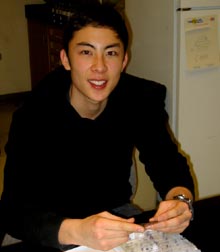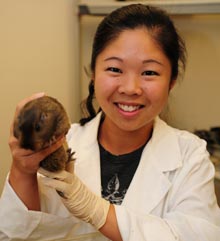Yohan Song

I am analyzing the vascular organization of the cat inferior colliculus (IC), a major auditory structure in the midtbrain, to determine whether its divisions share a common pattern. The IC consists of the central nucleus (CN), the dorsal cortex (DC), and the lateral cortex (LC), each with different roles in auditory behavior and perception. I am comparing the IC capillary distribution to quantify differences between subdivisions using plastic-embedded material from two adult cats in 1 m-thick semithin sections stained with toluidine blue. Ten non-overlapping random 200 x 200 m2 samples […]
Brandon Endo
There are forms of the gecko species, Heteronotia binoei, that reproduce sexually that gave rise to forms that reproduce asexually through the process of parthenogenesis. Parthenogens have sections of duplicated genes in their mitochondrial genome while sexual forms do not. My project is to sequence and compare the mitochondrial genes of the sexual and parthenogenic forms to characterize their evolution since their divergence. I will also compare duplicated gene copies to one another within the parthenogenic individuals to characterize evolution of each gene since the duplication event. Gene duplication and […]
Cristina Lau

As a third generation ethnic Chinese in Mexico, my research interests focus on the Chinese communities in Mexico. The Chinese people have reached many corners of the world primarily to search for new job opportunities and to start new homes. Especially active during the 19th century, the Chinese mostly migrated as coolies or contract workers, attracted to developing areas like Mexico where emerging economic needs and activities offered them job opportunities. Like my great-grandfather, with time and hard work, Chinese migrants in Mexico eventually started their own businesses, like Chinese […]
Megan Stanton

This summer I will be studying the life of Mary Rich, Countess of Warwick (1624-1678) as a case study for understanding the lives of aristocratic women in Early Modern England. Mary Rich is important and intriguing because aspects of her personality and lifestyle simultaneously conformed to and challenged the gender roles in her society. Both in the Countesss semi-independent attitude toward her marriage prospects and in her important role in community affairs in her local community in Essex, she defied traditional gender roles. However, with her conversion to a Puritan […]
Jude Paul Dizon
The majority of studies on Khmer refugees in the United States focus on their status as victims of war and displacement. I am undertaking a research project highlighting the transnational political movement of Khmer refugee communities in opposing and removing the Vietnamese occupation in Cambodia (1979-1993). Through examining the Hann So Collection on Cambodia Archives at the UC Berkeley Southeast Asian Studies Library, I hope to show how Khmer refugees were active agents in mitigating the pains of displacement by acting in very concrete measures to recuperate and rebuild Cambodia […]
Hai Le

It is essential that the cell preserves the integrity of its DNA by initiating a proper response when there is damage to its genome. As a fellow of the Summer Undergraduate Research Fellowships, I am utilizing this summer and the senior academic year to study the DNA repair pathway in heterochromatin. Using Drosophila melanogaster as a model system, I propose to fluorescently tag different DNA repair proteins and conduct experiments to understand the kinetics of these proteins following DNA damage induced by X-ray treatment. This research is promising: knowledge of […]
Shannon Swan

The Caucasus Mountains acted as a gateway for early hominids, who migrated into and through these regions, perhaps multiple times. Myshtulagty Lagat (Weasel Cave) is the first intact stratified cave studied in the Caucasus dating from 500,000 years BP to the Holocene. The cave lacks a well-stratified early upper Paleolithic sequence (c. 40.000-30.000 years ago, associated usually with our own species, Homo sapiens sapiens). Tracking Neanderthal climatic adaptations through faunal analysis allows for reconstruction of behavioral and dietary changes providing data imperative to interpreting site use and formation processes. Connections […]
Jenny Cooper
The U.S. government budget cuts of the 1980s and the international financial institutions economic policies of the late 1980s and 1990s crippled government-run social services in the U.S. and across the Third World. To fill the void left by the defunct government services there has been an unprecedented rise in the number of non-profit and community organizations in the U.S. and abroad. This begs numerous questions: To whom are these organizations accountable? From where does funding come? Who is deciding which projects get financial priority? My research attempts to understand […]
Angela Li

My research project focuses on depression to determine how it impacts interpersonal relationships and depressed individuals’ emotional responses. I am studying depression through a couple’s study involving 80 romantic couples. During the study, couples engage in a series of conversations about a sacrifice they made for each other, a time that they felt great love for their partner, and a time of suffering they experienced on their own. By analyzing the participant’s physiological, behavioral, and emotional responses during and after these conversations, I aim to find answers to the following […]
Maressa Takahashi

I work in Professor Eileen Laceys lab with a colony of tuco-tucos, which are subterranean rodents in the family Ctenomyidae. Although there are more than 50 species of tuco-tucos in South America, the species I am studying is unique in that they live in groups and related females share a single burrow system. As a result, social relationships between females are very important in this species. I am studying chemical communication between females. Specifically, I am testing the hypothesis that olfactory cues in urine may serve as indicators of individual […]